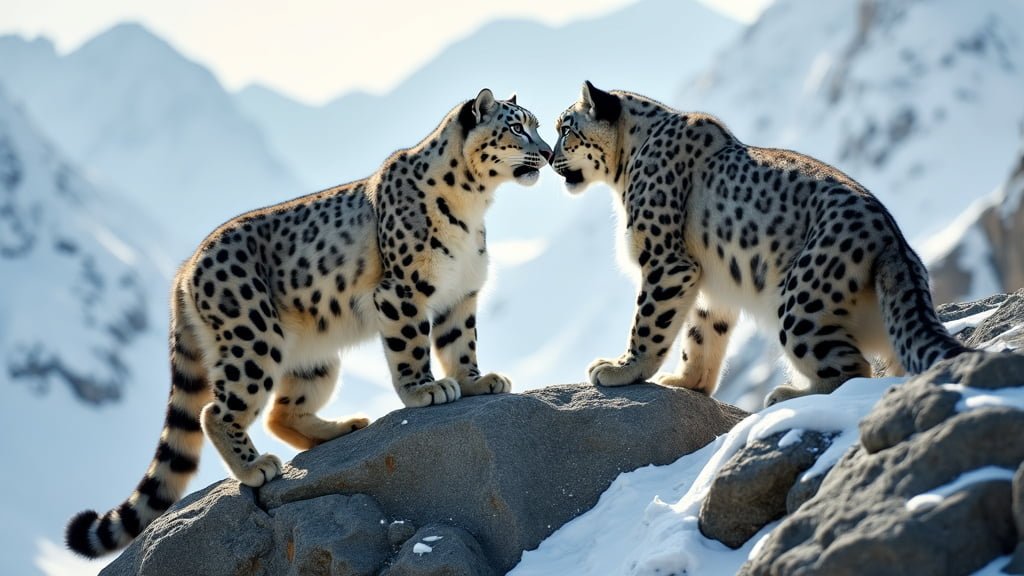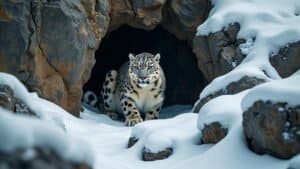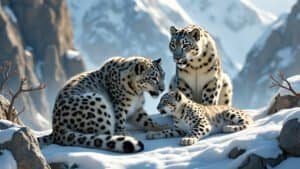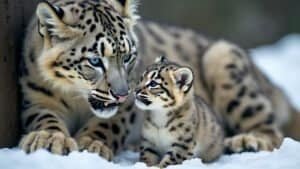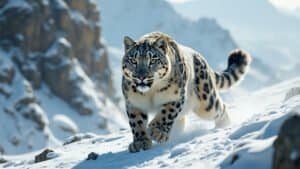Introduction
Snow leopards, elusive and majestic big cats of the high mountains, have unique and intricate mating behaviors that are crucial for their survival
This article explores the key aspects of snow leopard mating, including when and how they mate, their courtship rituals, and the significant role of scent marking and territory during the mating season
Additionally, it delves into the importance of the female’s role in the process and how environmental factors influence their reproductive behaviors. Understanding these behaviors is essential for conserving this endangered species and ensuring their continued presence in the wild
When Do Snow Leopards Mate?
Snow leopards are solitary animals that inhabit some of the most rugged and remote mountain ranges in the world, such as the Himalayas and the Altai Mountains
Their mating season is a critical period that is influenced by various environmental and biological factors. Understanding when snow leopards mate provides insight into their reproductive strategies and helps in conservation efforts, particularly because this species is listed as vulnerable due to habitat loss and poaching
Mating Season Timing
The mating season for snow leopards typically occurs in late winter, between January and March. This timing coincides with the harshest part of winter in the high-altitude regions they inhabit
During this time, snow leopards are more likely to come into contact with each other, as the scarcity of prey and the need for mating drive them to roam beyond their usual solitary territories. The specific timing within this window can vary slightly depending on the exact geographic location, but late winter remains the general period across most of their range
The synchronization of the mating season with the end of winter is crucial for the species. Snow leopards give birth in late spring or early summer, ensuring that their cubs are born during a time when the weather is milder and prey is more abundant
This seasonal timing is essential for the survival of the cubs, as the first few months are critical for their development, and access to sufficient food resources is vital
Environmental Factors Influencing Mating
Environmental factors play a significant role in the timing and success of snow leopard mating. The harsh winter conditions in the high mountains, characterized by deep snow and freezing temperatures, affect the availability of prey and the overall energy levels of these predators
The decrease in prey abundance during winter forces snow leopards to expand their range, which increases the likelihood of encountering potential mates
Additionally, the length of daylight and changes in temperature may trigger hormonal changes in snow leopards, prompting them to seek mates. The timing of snowmelt and the subsequent growth of vegetation can also indirectly influence the mating season, as these factors impact the distribution and behavior of prey species, which in turn affects the movement patterns of snow leopards
Regional Variations in Mating Periods
While late winter is generally the mating season for snow leopards, there can be regional variations depending on the specific environmental conditions of their habitat
For instance, in the more northern parts of their range, such as in the Altai Mountains of Mongolia, the mating season might start slightly earlier or later due to differences in climate and prey availability
In regions with more severe winters, snow leopards might delay mating until the conditions improve slightly, ensuring that the cubs are born when the environment is less hostile. Conversely, in areas with milder winters, the mating season could begin earlier, aligning with the earlier onset of spring and the availability of prey
These regional variations highlight the adaptability of snow leopards to their challenging environments and the importance of understanding local conditions when studying their reproductive behavior
Courtship Behaviors of Snow Leopards
Snow leopards, known for their elusive nature, exhibit a variety of subtle and complex behaviors during courtship. These behaviors are crucial in establishing bonds between potential mates and ensuring successful reproduction
The courtship process is a delicate dance of communication through vocalizations, physical gestures, and scent marking, all of which play a significant role in the mating ritual of these solitary felines
Vocalizations During Courtship
Vocalizations are a key component of snow leopard courtship. During the mating season, snow leopards become more vocal, using a range of sounds to communicate with potential mates
One of the most distinctive calls is the “sawing” sound, so named because it resembles the sound of wood being sawed. This vocalization is unique to snow leopards and is used primarily during the mating season to signal readiness and attract a mate
Both males and females produce this sound, though it is more commonly heard from males as they seek to locate receptive females within their expansive and rugged territories. In addition to sawing, snow leopards may also use other vocalizations such as growls, chuffing, and yowls. These sounds serve not only to attract mates but also to establish dominance or deter rivals
The vocalizations carry over long distances in the mountainous terrain, allowing snow leopards to communicate even when they are not in close proximity
Physical Displays and Gestures
Alongside vocalizations, physical displays play an important role in snow leopard courtship. These displays are often subtle and involve a range of behaviors designed to show the leopard’s strength, health, and readiness to mate
Males may demonstrate their fitness through territorial displays, such as patrolling and marking the boundaries of their territory more frequently during the mating season. This behavior not only communicates the male’s presence to rivals but also signals his availability to females
When a male encounters a receptive female, the interaction is characterized by a series of ritualistic behaviors. The male approaches the female cautiously, often circling her and exhibiting a combination of gentle nudges, nuzzling, and head rubbing
These gestures serve to reduce tension and build trust between the pair. If the female is receptive, she will respond with similar behaviors, indicating her willingness to mate. This mutual exchange of physical gestures is critical in ensuring a successful mating interaction
Additionally, snow leopards may engage in playful behavior as part of their courtship ritual. This can include mock sparring, rolling, and gentle biting, all of which help to establish a bond between the pair. This playfulness not only facilitates mating but also strengthens the relationship, which is crucial in a species where prolonged pair bonding is rare
Female Receptivity and Response
The role of the female in snow leopard courtship is active and selective. Female snow leopards exhibit signs of receptivity through both behavioral and physiological changes
As the mating season approaches, females enter estrus, a period during which they are fertile and ready to mate. During this time, they become more vocal and may increase their scent-marking activity to signal their readiness to potential mates
Females are known to be choosy when selecting a mate, and their receptivity can be influenced by the male’s displays of fitness, such as his ability to defend a territory or his success in hunting
A female may also assess the male’s vocalizations and physical displays to determine his suitability as a mate. If a female is not interested in a particular male, she may reject him by growling, hissing, or simply walking away
Once a female has accepted a male, the mating process involves repeated copulation over several days. This repeated mating increases the chances of successful fertilization, especially in the challenging environments snow leopards inhabit. After mating, the pair typically separates, and the female goes on to prepare for gestation, which lasts about 90-100 days
Territory and Scent Marking in Snow Leopards
Territory and scent marking are vital aspects of snow leopard behavior, especially during the mating season
These elusive cats rely heavily on their territorial instincts to establish dominance, attract mates, and communicate with other snow leopards in the vast and rugged landscapes they inhabit. Understanding how snow leopards use their territory and scent marking provides valuable insight into their reproductive strategies and social interactions
Role of Scent Marking
Scent marking is one of the primary ways snow leopards communicate, particularly during the breeding season
Snow leopards possess scent glands located on their cheeks, paws, and tail, which they use to leave chemical signals in their environment. These scent marks convey critical information about the individual’s identity, reproductive status, and territorial boundaries
During the mating season, both male and female snow leopards increase their scent-marking activities to signal their presence and readiness to mate. Males, in particular, are known to patrol their territory more frequently, marking prominent features such as rocks, trees, and overhangs with urine and gland secretions
This behavior serves a dual purpose: it reinforces the male’s territorial boundaries while also attracting females who may be passing through or residing within overlapping territories
Scent marking also plays a role in preventing conflicts between snow leopards. By recognizing the scent marks of others, snow leopards can avoid direct confrontations, which are energy-intensive and potentially dangerous
In this way, scent marking helps to maintain a delicate balance within the snow leopard population, allowing them to coexist in the challenging environments they call home
Territorial Disputes During Mating Season
While snow leopards are generally solitary, the mating season can lead to increased interactions and even disputes over territory. Males, in particular, may become more aggressive as they seek to protect their territory from rivals and secure access to receptive females
These disputes are often resolved through displays of dominance rather than physical altercations, though fights can occur if neither male backs down
Territorial disputes are more likely in areas where the snow leopard population density is higher, or where suitable habitat is limited. In such cases, the overlap of territories can lead to encounters between rival males. These interactions typically involve vocalizations, such as growls and yowls, as well as displays of size and strength, where the cats may arch their backs, puff up their fur, and bare their teeth
If a male snow leopard successfully defends his territory, he not only secures his mating opportunities but also reinforces his status within the local population
This status is critical for maintaining access to resources such as prey and mating partners, which are essential for survival and reproduction in the harsh mountain environments
Interaction with Potential Mates Through Territory
The size and quality of a male snow leopard’s territory can influence his success in attracting mates
Males with larger territories or those located in areas rich in prey are more likely to encounter and attract females. These territories often encompass key resources such as water sources, prey-rich hunting grounds, and sheltered areas suitable for raising cubs
Females, while generally less territorial than males, also use scent marking to communicate their presence and reproductive status. When a female enters a male’s territory, she may respond to his scent marks by adding her own, signaling her interest. The male, upon detecting the female’s scent, will actively seek her out, leading to the courtship behaviors discussed earlier
Territorial interactions between males and females are typically more cooperative during the mating season. While males may continue to patrol and mark their territories, they are also more tolerant of females entering their domain
This temporary relaxation of territorial boundaries is crucial for successful mating and ensures that both partners have access to the resources they need during the critical breeding period
The Role of Females in Snow Leopard Mating
In the mating dynamics of snow leopards, females play a critical and active role. Their behaviors and choices directly influence the success of reproduction, from mate selection to the care of offspring
Understanding the role of females provides a comprehensive view of snow leopard reproduction and highlights the strategies these solitary animals use to ensure the survival of their species in challenging environments
Female Mate Selection
Female snow leopards are selective when it comes to choosing a mate. This selectivity is crucial, as the harsh environments they inhabit require that their offspring have the best possible genetic advantages
During the mating season, females may roam across multiple male territories, assessing potential mates based on their scent marks, vocalizations, and physical displays
The process of mate selection is complex and involves evaluating the male’s fitness, which is indicated by factors such as the size and quality of his territory, his ability to hunt and defend his domain, and his overall health
A male that controls a large territory rich in prey is more likely to attract a female, as this suggests that he possesses the strength and resources necessary to support a family
Females also consider the male’s behavior during courtship. A male that displays patience, persistence, and gentleness during their interactions is more likely to be accepted as a mate. This behavioral assessment ensures that the female chooses a partner who not only has good genes but also exhibits behaviors that will contribute to the success of their offspring
Gestation Period and Post-Mating Behavior
Once mating has occurred, the female snow leopard enters a gestation period that lasts approximately 90 to 100 days. During this time, the female prepares for the arrival of her cubs by finding a suitable den
Dens are typically located in rocky crevices, caves, or other sheltered locations that provide protection from the harsh weather and potential predators. These sites are chosen for their inaccessibility and safety, ensuring that the cubs have the best chance of survival during their vulnerable early months
During the gestation period, the female becomes increasingly solitary and secretive, minimizing her movements to avoid drawing attention to herself and her future cubs. This period is critical for the development of the cubs, and the female’s energy is focused on ensuring their successful birth
After giving birth, the female snow leopard remains in the den with her cubs for several weeks, providing warmth, protection, and nourishment
The cubs are born blind and helpless, weighing just over a pound at birth, and they are entirely dependent on their mother. The female’s role is vital during this time, as her care and protection are crucial for the cubs’ survival
Female Independence Post-Mating
Once the cubs are old enough to begin exploring outside the den, the female snow leopard’s role shifts to that of a teacher and protector
She introduces her cubs to the challenges of their environment, teaching them how to hunt and navigate the rugged terrain. This period of learning and development is essential, as it prepares the cubs for independence
Female snow leopards are fiercely protective of their cubs and will go to great lengths to ensure their safety. They may move the cubs between different dens to avoid detection by predators or rival males. This behavior demonstrates the female’s strategic thinking and her critical role in the cubs’ early survival
As the cubs grow and become more self-sufficient, typically around 18 to 24 months of age, the mother gradually distances herself, encouraging them to establish their own territories. This separation is a natural part of the snow leopard’s life cycle, allowing the female to return to her solitary lifestyle and potentially prepare for another mating season
The female snow leopard’s independence post-mating is a key aspect of her survival strategy. By raising her cubs to be self-reliant and then returning to solitude, she conserves her energy and resources for future reproductive cycles
This cycle of reproduction and independence is essential for the continuity of the snow leopard population in the wild
Conclusion
The mating behaviors of snow leopards are a complex interplay of environmental cues, territorial instincts, and intricate social interactions. These elusive big cats mate primarily during the harsh winter months, a strategy that aligns the birth of their cubs with more favorable spring conditions
Through vocalizations, scent marking, and physical displays, snow leopards communicate their readiness and attract mates, while territorial disputes among males highlight the competitive nature of this period
Females play a crucial role, carefully selecting mates and providing intense care to their cubs during the early, vulnerable months of life. Understanding these behaviors is not only fascinating but essential for conservation efforts aimed at protecting this vulnerable species and ensuring their continued survival in the wild
